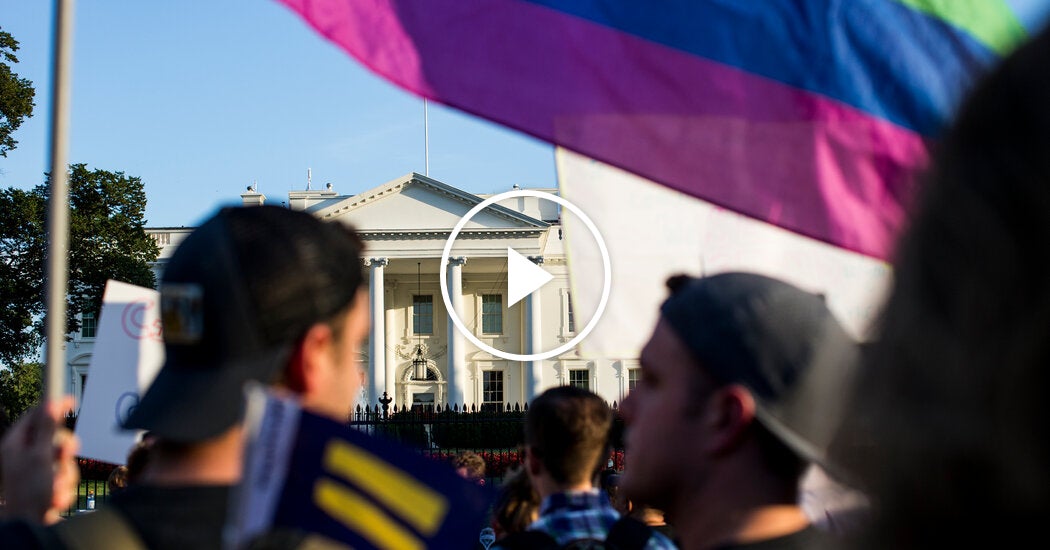Deconstructing The Rhetoric: Trump's Transgender Military Ban Explained

Table of Contents
The Justification for the Ban: A Closer Look at the Official Rationale
The official rationale behind Trump's transgender military ban rested on several pillars, all of which faced significant criticism and lacked substantial evidence. The administration cited concerns about:
-
Cost of healthcare for transgender service members: The argument centered on the purportedly high cost of hormone therapy and gender confirmation surgeries. However, critics pointed out that these costs were relatively small compared to the overall military healthcare budget, and that many transgender individuals already served without undue financial burden on the system. Furthermore, studies showed that denying healthcare increased overall costs associated with managing the health of transgender service members.
-
Disruption to military readiness and unit cohesion: The administration claimed that the presence of transgender individuals would negatively affect unit cohesion and readiness. This argument relied on unsubstantiated claims and stereotypes, ignoring the fact that transgender individuals already served successfully and discreetly for years. Research consistently shows that diversity enhances morale and effectiveness in military units.
-
Concerns about combat effectiveness: This justification was equally baseless, lacking any credible evidence to suggest transgender individuals are inherently less capable of fulfilling their military duties. The argument relied on outdated and prejudiced assumptions rather than data-driven analysis.
-
Reliance on outdated medical understandings of gender identity: The ban relied on outdated medical understanding of gender identity, ignoring the significant advancements in medical and psychological understanding of transgender individuals. This reflected a broader failure to acknowledge the evolving understanding of gender identity within the medical and scientific communities.
The Legal Battles and Court Challenges Surrounding the Ban
Trump's transgender military ban faced immediate and widespread legal challenges. The American Civil Liberties Union (ACLU), along with other legal organizations, filed multiple lawsuits arguing that the ban violated the constitutional rights of transgender service members, specifically the Fifth Amendment's guarantee of due process and equal protection under the law.
-
Involvement of different courts: The legal battles spanned various courts, from district courts to the Court of Appeals, with rulings often conflicting before reaching the Supreme Court.
-
Key legal arguments: Plaintiffs argued the ban was discriminatory and based on unfounded assumptions, violating their rights. The government defended the ban using arguments centered on military readiness and cost concerns, as detailed above.
-
Significant court decisions: Key court decisions consistently sided with the plaintiffs, ultimately leading to the ban's reversal. The courts found the government's arguments lacking in merit and the ban itself discriminatory.
The Impact of the Ban on Transgender Service Members
The human cost of Trump's transgender military ban was immense. The ban resulted in:
-
Emotional and psychological toll: Transgender service members faced increased stress, anxiety, and depression due to the uncertainty and fear of discharge. Many experienced significant emotional distress due to the stigmatization and discrimination.
-
Impact on careers and job security: The ban threatened careers and livelihoods, forcing many to leave the military or live in fear of discovery and dismissal. The resulting instability significantly impacted their lives and their families.
-
Difficulties accessing healthcare and support: The ban exacerbated access challenges to necessary healthcare, resulting in significant negative health implications for many. Support networks were disrupted, leaving many feeling isolated and alone.
-
Increased risk of discrimination and harassment: The ban fostered an environment of heightened discrimination and harassment, further isolating and endangering transgender service members.
The Long-Term Effects on Military Morale and Recruitment
Trump's transgender military ban had far-reaching implications beyond those directly affected. The ban:
-
Damaged the military's image and reputation: It projected a negative image of the military as an institution that discriminates against its own personnel, harming its global reputation and recruiting efforts.
-
Led to the potential loss of talented individuals: The ban resulted in the loss of highly skilled and dedicated individuals, weakening the military's overall capabilities.
-
Negatively impacted diversity and inclusion: The ban undermined efforts to create a more diverse and inclusive military, creating a less welcoming environment for all service members.
Conclusion
Trump's transgender military ban was a deeply flawed policy, based on unsubstantiated claims and fueled by harmful rhetoric. The legal battles that ensued exposed the lack of evidence supporting the ban's justification, and the human cost bore witness to its devastating consequences for transgender service members. The long-term effects on military morale, recruitment, and overall effectiveness highlight the dangers of discriminatory policies. Understanding the complexities of Trump's transgender military ban is crucial for fostering a more inclusive and informed discussion surrounding LGBTQ+ rights and military service. Continue learning about this important issue and advocate for policies that promote equality and acceptance within the armed forces. Further research into the impact of Trump's transgender military ban will help us better understand and prevent similar discriminatory policies in the future.

Featured Posts
-
 Vozmozhniy Noviy Naplyv Ukrainskikh Bezhentsev V Germaniyu Vliyanie Politiki S Sh A
May 10, 2025
Vozmozhniy Noviy Naplyv Ukrainskikh Bezhentsev V Germaniyu Vliyanie Politiki S Sh A
May 10, 2025 -
 Scientific Research And Funding The Case Of Transgender Mice In The Us
May 10, 2025
Scientific Research And Funding The Case Of Transgender Mice In The Us
May 10, 2025 -
 Russian Gas Pipeline Elliott Managements Exclusive Play
May 10, 2025
Russian Gas Pipeline Elliott Managements Exclusive Play
May 10, 2025 -
 Leon Draisaitl Injured Edmonton Oilers Leading Goal Scorer Leaves Game
May 10, 2025
Leon Draisaitl Injured Edmonton Oilers Leading Goal Scorer Leaves Game
May 10, 2025 -
 Stock Market Prediction 2 Companies To Outpace Palantir Within 3 Years
May 10, 2025
Stock Market Prediction 2 Companies To Outpace Palantir Within 3 Years
May 10, 2025
